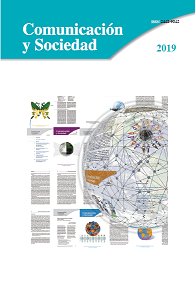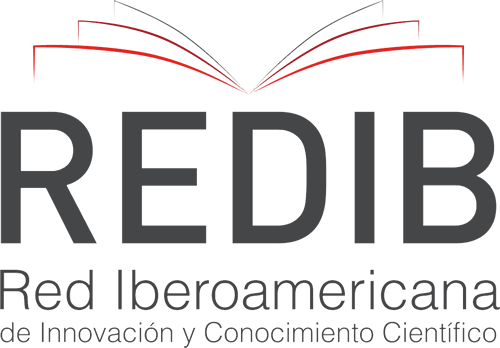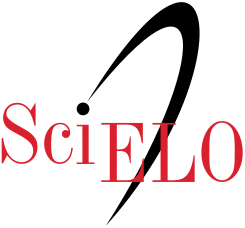Las partes y el todo de la historia: Ejemplos como estrategia argumentativa en las noticias chilenas
DOI:
https://doi.org/10.32870/cys.v2019i0.7314Palabras clave:
Análisis de contenido, Chile, Noticias, Periodismo, PeriódicosResumen
La ejemplificación es clave para la percepción de las personas sobre el mundo y es común en los medios. Los ejemplos en las noticias, sin embargo, no son necesariamente precisos y podrían confundir a la audiencia. A partir de un análisis de contenido, este trabajo examina la presencia de casos particulares (ejemplos) en una muestra de diarios chilenos de 1991 a 2015. Los resultados muestran que la ejemplificación está extendida en la prensa de Chile, con un continuo aumento a lo largo de los años.Descargas
Citas
Andersen, K., Skovsgaard, M., Albæk, E. & de Vreese, C. H. (2017). The engaging effect of exemplars: How an emotional reaction to (dis)similar people in the news media affects political participation. The International Journal of Press/Politics, 22, 490-509. DOI: https://doi.org/10.1177/1940161217723152
Arpan, L. (2009). The effects of exemplification on perceptions of news credibility. Mass Communication & Society, 12, 249-270. DOI: https://doi.org/10.1080/15205430802136721
Bachmann, I. & Mujica, C. (2019). Exemplars as argumentative strategy in broadcast news: Analyzing the case of Chile. Journalism Practice [Advance online publication]. DOI: https://doi.org/10.1080/17512786.2019.1618198
Bas, O. & Grabe, M. E. (2015). Emotion-provoking personalization of news: Informing citizens and closing the knowledge gap? Communication Research, 42(2), 159-185. DOI: https://doi.org/10.1177/0093650213514602
Bas, O. & Grabe, M. E. (2016). Personalized news and participatory intent: How emotional displays of everyday citizens promote political involvement. American Behavioral Scientist, 60, 1719-1736. DOI: https://doi.org/10.1177/0002764216676247
Brosius, H. B. (1999). The Influence of exemplars on recipients' judgements: The part played by similarity between exemplar and recipient. European Journal of Communication, 14(2), 213-224. DOI: https://doi.org/10.1177/0267323199014002004
Díaz, M. & Mellado, C. (2017). Agenda y uso de fuentes en los titulares y noticias centrales de los medios informativos chilenos. Un estudio de la prensa impresa, online, radio y televisión. Cuadernos.info, 40, 107-121. DOI: https://doi.org/10.7764/cdi.40.1106
Fermandois, E. (2003). Un ejemplo, una razón. Revista Universitaria, 80, 14-17.
Fine, G. A. & White, R. D. (2002). Creating collective attention in the public domain: Human interest narratives and the rescue of Floyd Collins. Social Forces, 81, 57-85. DOI: https://doi.org/10.1353/sof.2002.0046
Geller, A. J. (2005). Some stories hurt more: The interaction of salience and exemplification on audience perception in news reports (Unpublished bachelor's thesis). University of North Carolina, Chapel Hill.
Gerbner, G., Gross, L., Morgan, M., Signorielli, N. & Jackson-Beeck, M. (1979). The demonstration of power: violence profile No. 10. Journal of Communication, 29, 177-196. DOI: https://doi.org/10.1111/j.1460-2466.1979.tb01731.x
Gibson, R. & Zillmann, D. (1998). Effects of citation in exemplifying testimony on issue perception. Journalism & Mass Communication Quarterly, 75, 167-176. DOI: https://doi.org/10.1177/107769909807500116
Gibson, R., Callison, C. & Zilmann, D. (2011). Quantitative literacy and affective reactivity in processing statistical information and case histories in the news. Media Psychology, 14, 96-120. DOI: https://doi.org/10.1080/15213269.2010.547830
Gómez, L. & Capdevila, A. (2012). Variaciones estratégicas en los spots electorales de televisión y de Internet en campaña electoral. ZER Revista de Estudios de Comunicación, 17, 67-86. Retrieved from https://www.ehu.eus/ojs/index.php/Zer/article/view/10615
Gronemeyer, M. E. (2013). La digitalización y sus efectos sobre las prácticas y productos periodísticos en Chile. Palabra Clave, 16, 101-128. DOI: https://doi.org/10.5294/pacla.2013.16.1.4
Gronemeyer, M. E. & Porath, W. (2013). Los niveles de coincidencias temáticas en editoriales de cinco diarios chilenos de referencia en un contexto de concentración de la propiedad de los medios. Estudios sobre el Mensaje Periodístico, 19(1), 433-452. DOI: https://doi.org/10.5209/rev_ESMP.2013.v19.n1.42531
Gronemeyer, M. E. & Porath, W. (2015). A study on homogeneity between editorials and news sources opinions in the Chilean reference press. Cuadernos.info, 36, 139-153. DOI: https://doi.org/10.7764/cdi.36.567
Grabe, M. E., Kleemans, M., Bas, O., Gall Myrick, J. & Kim, M. (2017). Putting a human face on cold, hard facts: Effects of personalizing social issues on perceptions of issue importance. International Journal of Communication, 11, 907-929.
Hernández Olmedo, J.L. (2016). El camino persuasivo de los valores en la propaganda televisiva. Comunicación y Sociedad, 27, 145-172. Retrieved from https://ijoc.org/index.php/ijoc/article/view/4824
Hopmann, D. N., Skovsgaard, M. & Elmelund-Præstekær, C. (2017). What have I done to deserve this? The role of deservingness in effects of ordinary citizens as cases in the news. European Journal of Communication, 32(4), 333-347. DOI: https://doi.org/10.1177/0267323117710900
Humanes, M. L., Mellado, C. & Márquez-Ramírez, M. (2017). La presencia del método objetivo en los contenidos noticiosos de la prensa de Chile, México y España. Comunicación y Sociedad, 29, 165-184. DOI: https://doi.org/10.32870/cys.v0i29.5738
Hwang, Y. & Jeong, S. H. (2012). Public’s responses to aviation accidents: The role of exemplification and attributions, Journal of Applied Communication Research, 40, 350-367. DOI: https://doi.org/10.1080/00909882.2012.712709
Igartua, J. J., Cheng, L., Moral, F., Fernández, I., Frutos, F. J. Gómez Isla, J. M., & Otero, J. (2008). Encuadrar la inmigración en las noticias y sus efectos socio-cognitivos. Palabra Clave, 11, 87-107. Retrieved from https://palabraclave.unisabana.edu.co/index.php/palabraclave/article/view/1418/1728
Lefevere, J., De Swert, K. & Walgrave, S. (2012). Effects of popular exemplars in television news. Communication Research, 39, 103-119. DOI: https://doi.org/10.1177/0093650210387124
Lule, J. (2001). Daily news, eternal stories: the mythological role of journalism. New York: Guilford Press.
Mellado, C. & Lagos, C. (2014). Professional roles in news content: Analyzing journalistic performance in the Chilean national press. International Journal of Communication, 8, 2090-2112. Retrieved from https://ijoc.org/index.php/ijoc/article/view/2651
McCombs, M. E., López-Escobar, E. & Llamas, J. P. (2000). Setting the agenda of attributes in the 1996 Spanish general election. Journal of Communication, 50(2), 77-92. DOI: https://doi.org/10.1111/j.1460-2466.2000.tb02842.x
McCombs, M. E. & Shaw, D. L. (1972). The agenda-setting function of mass media. Public Opinion Quarterly, 36(1), 176-187. DOI: https://doi.org/10.1086/267990
Mujica, C. & Bachmann, I. (2013). Melodramatic profiles of Chilean newscasts: the case of emotionalization. International Journal of Communication, 7, 1801-1820. Retrieved from https://ijoc.org/index.php/ijoc/article/view/2177/971
Mujica, C. & Bachmann, I. (2015). How Chilean editors perceive and define the role of melodrama in television news. Palabra Clave, 18(2), 312-340. Retrieved from https://palabraclave.unisabana.edu.co/index.php/palabraclave/article/view/4603
Neuendorf, K. (2002). The Content Analysis Guidebook. Thousand Oaks: Sage.
Oliver, M. B., Dillard, J. P., Bae, K. & Tamul, D. J. (2012). The effect of narrative news format on empathy for stigmatized groups. Journalism & Mass Communication Quarterly, 89, 205-224. DOI: https://doi.org/10.1177/1077699012439020
Pellegrini, S., Puente, S., Porath, W., Mujica, C. & Grassau, D. (2011). Valor agregado periodístico, la apuesta por la calidad de las noticias. Santiago: Ediciones UC.
Perelman, C. & Olbrechts-Tyteca, L. (1969). The new rhetoric: A treatise on argumentation. Notre Dame: University of Notre Dame Press.
Porath, W., Vergara, E., Gómez-Lorenzini, P. & Labarca, C. (2017). Cambios en la presentación de los personajes de la publicidad del retail en Chile en un contexto de modificaciones en la lógica de consumo asociadas a transformaciones socioculturales (1997-2013). Comunicación y Sociedad, 29, 203-225. DOI: https://doi.org/10.32870/cys.v0i29.5635
Puente, S. (1997). Televisión: el drama hecho noticia. Santiago: Ediciones UC.
Puente, S. & Mujica, C. (2011). ¿Qué es noticia (en Chile)? Cuadernos.info, 16, 85-100. DOI: https://doi.org/10.7764/cdi.16.162
Riffe, D., Aust, C. F. & Lacy, S. R. (1993). The effectiveness of random, consecutive day and constructed week sampling in newspaper content analysis. Journalism Quarterly, 70, 133-139. DOI: https://doi.org/10.1177/107769909307000115
Saavedra, G. (1996). Escribir es –también en periodismo– argumentar. Cuadernos de Información, 11, 116-127. DOI: https://doi.org/10.7764/cdi.11.226
Semetko, H. & Valkenburg, P. (2000). Framing European politics: a content analysis of press and television news. Journal of Communication, 50, 93-109. DOI: https://doi.org/10.1111/j.1460-2466.2000.tb02843.x
Shoemaker, P. J. & Reese, S. D. (2013). Mediating the message in the 21st Century: A Media Sociology Perspective. New York: Routledge.
Sunkel, G. (2005). Narrativas periodísticas y escándalos políticos: El caso Mop-Ciade. Comunicación y Medios, 15, 85-100. DOI: https://doi.org/10.5354/0719-1529.2011.12084
Valkenburg, P., Semetko, H. & de Vreese, C. (1999). The effects of news frames on reader’s thoughts and recall. Communication Research, 26, 550-569. DOI: https://doi.org/10.1177/009365099026005002
Vanderford, M. L. & Smith, D. (1996). The silicone breast implant story: Communication and uncertainty. Mahwah: Lawrence Erlbaum.
Westerman, D., Spence, P. R. & Lachlan, K. A. (2009). Telepresence and the exemplification effects of disaster news. Communication Studies, 60, 542-557. DOI: https://doi.org/10.1080/10510970903260376
Westerman, D., Spence, P. R. & Lachlan, K. A. (2011). Telepresence and exemplification: Does spatial presence impact sleeper effects? Communication Reports, 28, 299-309. DOI: https://doi.org/10.1080/08934215.2014.971838
Zerback, T. & Fawzi, L. (2017). Can online exemplars trigger a spiral of silence? Examining the effects of exemplar opinions on perceptions of public opinion and speaking out. New Media & Society, 19(7), 1034-1051. DOI: https://doi.org/10.1177/1461444815625942
Zillmann, D. (1999). Exemplification theory: Judging the whole by some of its parts. Media Psychology, 1(1), 69-94. DOI: https://doi.org/10.1207/s1532785xmep0101_5
Zillmann, D. (2002). Exemplification theory of media influence. In J. Bryant & D. Zillmann (Eds.), Media effects: Advances in theory and research (pp. 19-41). Mahwah: Lawrence Erlbaum.
Zillmann, D. (2006). Exemplification effects in the promotion of safety and health. Journal of Communication, 56, S221–S237. DOI: https://doi.org/10.1111/j.1460-2466.2006.00291.x
Zillmann, D. & Brosius, H. B. (2000). Exemplification in communication: The influence of case reports on the perception of issues. Mahwah: Lawrence Erlbaum.
Descargas
Publicado
Cómo citar
Número
Sección
Licencia
Los autores/as que publiquen en esta revista aceptan las siguientes condiciones:
De acuerdo con la legislación de derechos de autor, los autores conservan los derechos de autoría y otorgan a Comunicación y Sociedad el derecho de primera comunicación pública de la obra. Comunicación y Sociedad no realiza cargos a los autores por enviar y procesar artículos para su publicación.
Los autores/as pueden realizar otros acuerdos contractuales independientes y adicionales para la distribución no exclusiva de la versión del artículo publicado en Comunicación y Sociedad (por ejemplo incluirlo en un repositorio institucional o publicarlo en un libro) siempre que indiquen claramente que el trabajo se publicó por primera vez en Comunicación y Sociedad.











